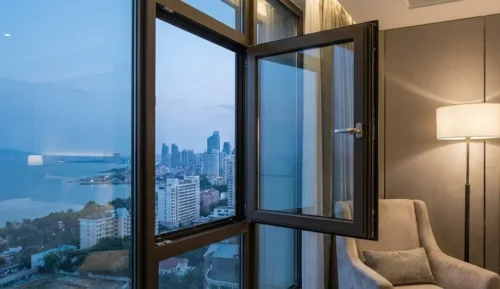Aluminum doors and windows are modern, durable, and energy-efficient options that enhance both aesthetics and functionality.

Understanding their manufacturing process is crucial for making informed purchase decisions or tackling DIY projects with confidence.
Design and Measurement

The design phase ensures that aluminum doors and windows meet client needs.
Precise measurements are crucial to creating a perfect fit.
Client preferences, building aesthetics, and performance requirements influence the design choices for customization, ensuring functionality and style.
Aluminum Extrusion Process

Aluminum extrusion is the process of shaping aluminum profiles by forcing it through a die.
This process forms frames, sashes, and mullions.
Heat (375°C-500°C), die design, and material quality determine the shape, strength, and durability of the profiles.
Cutting, Assembly, and Welding

Once the aluminum profiles are extruded, they are cut to specific dimensions.
Assembly methods include mechanical fasteners or welding, depending on the design.
Precision in cutting and assembly is essential for ensuring the structural integrity of the final door and window.
Surface Treatment and Finishing
Surface treatments like anodizing and powder coating protect against corrosion and enhance appearance.
Anodizing forms a protective oxide layer, while powder coating offers vibrant, long-lasting colors.
Custom finishes provide aesthetic versatility and improve durability in various environmental conditions.
Glazing Process
The glazing process involves installing glass panes into the aluminum frame.
Options include single-pane, double-pane, and energy-efficient glass.
Gaskets and sealants securely hold the glass, while glazing enhances thermal performance, reducing heat transfer and improving energy efficiency.
Hardware Installation

Essential hardware like locks, handles, hinges, and weatherstripping ensures the functionality, security, and energy efficiency of aluminum doors and windows.
Proper hardware selection improves durability, ease of use, and seals against drafts, enhancing overall performance.
Common Challenges in Aluminum Door and Window Making

Creating aluminum doors and windows can be complex, with challenges such as design adjustments, temperature control during extrusion, and coating adhesion.
Installation also poses potential issues, but proper planning and quality control can minimize them.
Design Adjustments: Customization can be tricky, requiring precise measurements and materials.
Temperature Control in Extrusion: Maintaining optimal temperatures during extrusion ensures consistent quality.
Coating Adhesion: Ensuring coatings adhere properly to prevent corrosion and ensure aesthetics.
Installation Issues: Proper handling and professional installation prevent misalignment or damage.
Conclusion

Making aluminum doors and windows involves key steps such as design, extrusion, assembly, surface treatment, glazing, and hardware installation.
Each process ensures high performance, durability, and aesthetics.
For custom designs or expert installation, contact us today!
Our professionals are ready to guide you through every step of your project.
![Apro logo - Common Aluminum Door Defects & How to Fix Them [November 2025] - APRO Apro logo](https://aprowin.com/wp-content/uploads/2024/08/Apro-logo.webp)
![A bifold glass door opens to a serene courtyard featuring a beautiful fountain at its center - Common Aluminum Door Defects & How to Fix Them [November 2025] - APRO A bifold glass door opens to a serene courtyard featuring a beautiful fountain at its center](https://aprowin.com/wp-content/uploads/2024/10/A-bifold-glass-door-opens-to-a-serene-courtyard-featuring-a-beautiful-fountain-at-its-center.webp)
![Sunflower view through modern black aluminum window frame - Common Aluminum Door Defects & How to Fix Them [November 2025] - APRO Sunflower view through modern black aluminum window frame](https://aprowin.com/wp-content/uploads/2024/10/Sunflower-view-through-modern-black-aluminum-window-frame.webp)
![Modern entrance featuring glass doors and awning for commercial projects - Common Aluminum Door Defects & How to Fix Them [November 2025] - APRO Modern entrance featuring glass doors and awning for commercial projects](https://aprowin.com/wp-content/uploads/2024/10/Modern-entrance-featuring-glass-doors-and-awning-for-commercial-projects.webp)
![Stylish residential project showcasing modern architecture and a beautiful pool area - Common Aluminum Door Defects & How to Fix Them [November 2025] - APRO Stylish residential project showcasing modern architecture and a beautiful pool area](https://aprowin.com/wp-content/uploads/2024/10/Stylish-residential-project-showcasing-modern-architecture-and-a-beautiful-pool-area.webp)



![gray door with silver handle sign that says no - Are Aluminum Doors Better Than Upvc? [November 2025] - APRO gray door with silver handle sign that says no](https://aprowin.com/wp-content/uploads/2024/09/gray-door-with-silver-handle-sign-that-says-no-500x280.webp)
![Sliding glass doors opening to a poolside view in a living room - How Much Does a Door Cost? Door Installation Guide [2025] - APRO Sliding glass doors opening to a poolside view in a living room](https://aprowin.com/wp-content/uploads/2024/11/Sliding-glass-doors-opening-to-a-poolside-view-in-a-living-room-500x328.webp)
![Living room with sliding glass doors leading to a balcony - Standard Door Sizes: Essential Guide for Homeowners [2025] - APRO Living room with sliding glass doors leading to a balcony](https://aprowin.com/wp-content/uploads/2024/11/Living-room-with-sliding-glass-doors-leading-to-a-balcony-500x333.webp)
![Two garage doors with windows and overhead door mechanism - How to Adjust Garage Door Springs: Easy Guide [2025] - APRO Two garage doors with windows and overhead door mechanism](https://aprowin.com/wp-content/uploads/2025/02/Two-garage-doors-with-windows-and-overhead-door-mechanism-500x320.webp)
![APRO logo white - Common Aluminum Door Defects & How to Fix Them [November 2025] - APRO APRO logo white](https://aprowin.com/wp-content/uploads/2024/07/APRO-logo-white.webp)